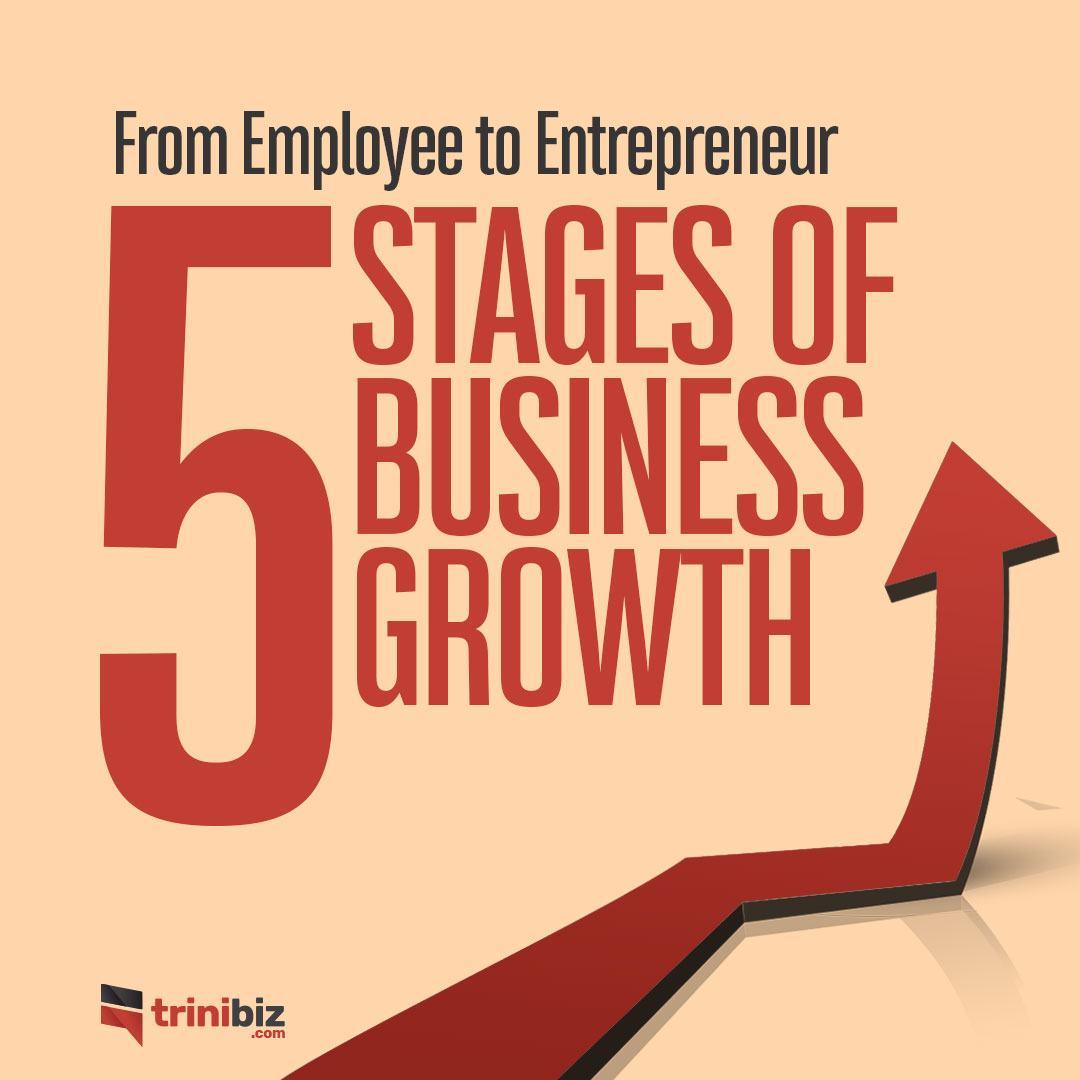Understanding the Path of Entrepreneurship and the 5 Stages of Business Growth. Let’s get it out the way one time, it’s no secret, most startups fail. And in Trinidad and Tobago, most of these businesses fail before they even start!
You know why?
We seem to have this belief that having an “idea”, in which the person usually thinks it is so brilliant and is guaranteed to make them a fortune someday, is a solid foundation for a business.
Because of this, they believe they need to protect this idea so dearly that no one steals it and “robs” them of their imagined fortunes. Let me save you some stress, 9 and half times out of 10, your idea is not that great, and it probably isn’t worth that much, if anything at all.
Ideas aren’t worth that much, businesses are.
But what is a business? Simply put it’s a system that is designed to deliver value by solving problems and making a profit in the process.
The truth of the matter is business is a team sport. You need other people to work with you to transform your idea into a real viable business, so free tip…. you can’t do that by being secretive and fearful of someone stealing your “idea”. That being said, let’s get into it.
The truth is, many of a startup’s mistakes that often lead to failure are preventable. There are certain basic principles that, if you get, dramatically increase your chances of being successful, or at the very minimum, making it onto another stage of growth.
See, business is a pretty good blend of art and science. It’s a science to the extent that it is based on large amounts of organised knowledge, which usually allows us to follow certain formulas when we’re trying to get specific results. In an artistic sense, most of what works are largely based on subjective tastes, as you may be heaven-sent for one set of customers, whereas another group may not bat an eye in your direction.
The value of a scientific approach is extremely useful in understanding the various stages of typical business growth as it allows us to prepare for those stages, ultimately increasing our chances of success. Below we shall explore such an approach.
Developing a Small Business Framework
Typically, categorizing the problems and growth patterns of small businesses in a way that is useful seems to be a major challenge at first. After all, small businesses vary widely in size, structure and potential for growth.
Yet on closer look, it becomes apparent that they experience common problems arising at similar stages in their development. It is believed that if we understand these stages of growth, often characterized by factors of managerial style, business structure, the extent of formal systems, strategic goals, and the owner’s involvement in the business, we can build better businesses with strong chances of success.
Stage 1. Ideation

Also called the startup or validation stage. The goal at this stage is figuring out the right thing to build that customers want and will pay. This is effectively where we adopt the principles of science and the practice of testing hypotheses and experimentation.
In this stage, the main problems of the business are obtaining customers and delivering the product or service they believe their market wants, and are willing to pay for, aka the hypotheses.
At this stage the 4 core questions to be answered are:
- What problem are we solving?
- Who are we solving this problem for?
- Can we profitably solve this problem?
- Is there the possibility for long term growth in solving this problem?
The organization is a simple one at this stage—the owner does everything. Systems and formal planning are minimal to nonexistent. The company’s strategy is simple, figure out if we have a solution customers actually want and are willing to pay for.
At this point, the owner is the business, without the owner, there is no business. The owner performs all the tasks and is the major supplier of energy, direction and capital.
The truth is many such companies never gain sufficient customer acceptance or product capability to become viable. In most cases, the owner, usually burnt out and exhausted, closes the business when the start-up capital runs out or, IF they’re lucky, sells the business for its asset value, most times at a loss.
In some cases, due to the demands the business places on their time, finances, and energy, owners are unable to manage it, so they quit. Those companies that remain in business go onto the next stage- Survival.
Stage 2. Survival

At this stage, the major goal is making enough money to cover this month’s bills, and often many companies are just barely making it. The owner is still synonymous with the business even though they may have a small team of 3-4 employees. Neither of them makes any major decisions independently, but instead, simply carry out the instructions of the owner.
In reaching this stage, the business has demonstrated that it is a viable entity. It has a few customers and satisfies them sufficiently with its products or services to keep them.
Systems development is minimal. Formal planning is sometimes none existent as most of these businesses are usually run on a “management by crisis” scenario.
At this point, some businesses may grow in size and profitability and move on to Stage 3. Or as many companies do, they remain at the Survival Stage for some time, earning marginal returns on invested time and capital, and eventually go out of business when the owner gives up or retires. Some of these businesses may develop enough economic viability to ultimately be sold, usually at a slight loss. Or they may fail completely and disappear from memory.
Stage 3. Success

At this point, the business has gained stability and is often predictably profitable. They’ve established themselves in a marketplace sufficiently to provide them with economic success.
As the business grew, it exceeded the owner’s ability to manage everything themselves, as a result, there now exists a line of managers responsible for overseeing the staff responsible for producing the product or service the business provides. At this stage, the owner(s) now decide to utilize the businesses success to do something else, like start another business, or maintain the company as is and use it to finance their lifestyle.
With some basic financial, marketing, and production systems in place and managers to operate the system, owners can now disengage from the daily operations of the business and are free to place their attention elsewhere.
Planning is usually in the form of departmental budgets that support specific strategic objectives. The owner and, to a lesser extent, the company’s managers, monitor a strategy to essentially maintain the status quo.
The company can stay at this stage indefinitely, some often do, but only provided the environment they operate within does not change and destroy its market niche or ineffective management reduces its competitive abilities.
If the company can continue to adapt to environmental changes, it can continue as is, be sold or merged at a profit, or subsequently move onto the Growth Stage. If the company cannot adapt to changing circumstances, as is the case in many instances, it will either fold or drop back to a marginally surviving company.
Stage 4: Growth

Getting to this level is usually a sign of a company that has attained true economic success. They have sufficient size, possible brand recognition and presence and a target market within a suitable industry that is large enough to ensure continued expansion.
They also typically earn above-average profits providing significant cash flows to sustain business operations and generate a number of opportunities for reinvestment.
At this point, which can prove to be a pivotal stage, the company’s success largely depends on having the right team in place and having a system that allows that team to work effectively together and handle a growing business, operating in an often complex business environment.
The systems, at this stage, are becoming more refined and extensive. Both operational and strategic planning is being executed across a team of core managers. The owner and the business have become reasonably separate, yet the company is still influenced largely by both owner’s presence and controlling interest.
Managing high growth often requires a very delicate balance. In one instance, a company may try to grow too fast and run out of cash. Or they are unable to delegate effectively to a team strong enough to make the company work.
If the owner can manage the challenge of a growing company, both financially and managerially, it can become a big business. If not, it can usually be sold, at a great profit, allowing the owner to exit.
If the company fails to make it big, it may be able to fall back to a Success stage and continue as a successful and substantial company once it can maintain the status quo. If however, the problems are too extensive, it may drop all the way back to the Survival Stage or even fail.
Stage 5. Maturity

Few companies successfully reach maturity, but it has the advantages of size, financial resources, and managerial talent at this point of the journey. If it can preserve its entrepreneurial spirit, it can eventually become an industry leader.
The owner and the business are separate, often have a clear distinction between the owners and the group of managers who operate the business.
A company at maturity has the ability to engage its staff and financial resources in the pursuit of detailed strategic objectives. The management is typically separated from the ownership, the company is adequately staffed, and experienced with systems that are extensive and well developed.
One of the greatest concerns of a business at this stage is maintaining agility and not becoming complacent. Typically characterised by the phrase, “this is how we’ve always done it here.”
Complacency in business is typically characterized by a lack of innovation and the avoidance of risks. Often common in large corporations whose sizable market share, buying power, and financial resources keep them viable until there is a major change in the environment.
Unfortunately for these businesses, competition is always knocking at the door in the form of rapidly growing, often smaller and more agile companies vying for their share of the market. If companies at this stage of growth don’t adapt well enough or fast enough, their decline soon follows.
Why Does This All Matter?
As a business moves from one stage to another, its focus shifts from one area of importance to another. At its core, it comes down to a business owner’s ability to manage 4 main factors that can determine their success.
- Human Resources – starting with the owner themselves and extending to who they hire.
- Financial Resources – starting capital and cash flow management as well as borrowing power
- System Resources – operating procedures, information systems and strategies and plans.
- Business Resources– brand assets, customer experience and relations and reputation, all of which help position a company in the marketplace.
In the early stages of the business, all success depends on the owner’s ability to execute on their vision and give life to the business. A small business is built on the owner’s talent, the ability to identify a problem, craft a solution, market and distribute that solution to an audience that is willing to pay them and then still make sense of the finances which usually never seem to be enough.
And if that doesn’t seem like a challenge enough, as the business grows, an owner’s ability to lead others is put to the test, as they are now in a position where the business starts demanding skills beyond the owner and he now has to manage the skills of others in accordance with what is required. And it is often at that point, the business either survives and grows, or the owner gets tired, exhausted and discouraged, and the business dies.
Knowing exactly where you are on your entrepreneurial journey can help you make more informed decisions on what you should focus on, and what you need to grow to the next stage. That information is crucial as it allows you to prepare yourself and your company for what lies ahead.
While every business is unique in many ways, we all face similar problems and are all subjected to great changes. No one ever said owning a business is easy, if it were, everyone would do it, but while it may not be easy, if you’re in it for the right reasons, it most certainly is worth it.








